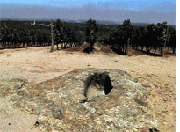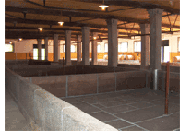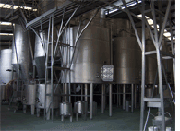 Dão is a region with a strong winegrowing tradition. Until recently, traditional winemaking methods were still used, in which the grapes were crushed in granite presses or wood vats, either underfoot or using a manual roll crusher.
Dão is a region with a strong winegrowing tradition. Until recently, traditional winemaking methods were still used, in which the grapes were crushed in granite presses or wood vats, either underfoot or using a manual roll crusher.
With the modernisation of wineries, the presses were replaced by roll destemmers and crushers. Fermentation tanks are now made of stainless steel and the wine is pressed in pneumatic or automatic threading presses.
 The effects of modernisation are also visible in the grape varieties used in winemaking. At the beginning of the century, Touriga Nacional was the dominant grape variety in the region’s vineyards; however, more productive and resistant grape varieties arose, relegating Touriga Nacional to second plan. With the modernisation of wineries, this grape variety started to be used again in winemaking.
The effects of modernisation are also visible in the grape varieties used in winemaking. At the beginning of the century, Touriga Nacional was the dominant grape variety in the region’s vineyards; however, more productive and resistant grape varieties arose, relegating Touriga Nacional to second plan. With the modernisation of wineries, this grape variety started to be used again in winemaking.
The region also produced a wine that farmers used to drink. It was produced with red and white  grape varieties and underwent slight fermentation on or off skins. It was not a deeply coloured wine and its alcohol content was between 11% and 11.5%. This wine has inspired the creation of some rosé wines.
grape varieties and underwent slight fermentation on or off skins. It was not a deeply coloured wine and its alcohol content was between 11% and 11.5%. This wine has inspired the creation of some rosé wines.
The new red wines from Dão are characterised by their intense colour. These are full bodied, alcoholic wines with balanced acidity. They have good longevity: ageing transforms their aromas and their flavour becomes more velvety. White wines are characterised by their citrine colour and smooth aroma.
 Back to map
Back to map